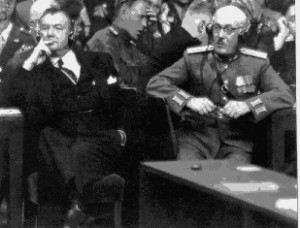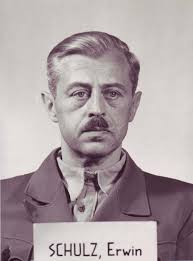Nuremberg Trials
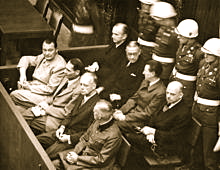
Judgment at Nuremberg (1961)
In 1948, an American court in occupied Germany tries four Nazi judges for war crimes.
 The Holocaust
The Holocaust
The Nuremberg Trials were a series of military tribunals, held by the Allied forces of World War II, most notable for the prosecution of prominent members of the political, military, and economic leadership of Nazi Germany. The trials were held in the city of Nuremberg. The first and best known of these trials, described as “[t]he greatest trial in history” by Norman Birkett, one of the British judges who presided over it, was the trial of the major war criminals before the International Military Tribunal (IMT). Held between 20 November 1945 and 1 October 1946, the Tribunal was given the task of trying 23 of the most important political and military leaders of the Third Reich, though one of the defendants, Martin Bormann, was tried in absentia, while another, Robert Ley, committed suicide within a week of the trial’s commencement. Not included were Adolf Hitler, Heinrich Himmler, and Joseph Goebbels, all of whom had committed suicide several months before the indictment was signed. The second set of trials of lesser war criminals was conducted under Control Council Law No. 10 at the US Nuremberg Military Tribunals (NMT); among them included the Doctors’ Trial and the Judges’ Trial. This article primarily deals with the IMT; see the Subsequent Nuremberg Trials for details on those trials.
Origin
There were, I suppose, three possible courses: to let the atrocities which had been committed go unpunished; to put the perpetrators to death or punish them by executive action; or to try them. Which was it to be? Was it possible to let such atrocities go unpunished? Could France, could Russia, could Holland, Belgium, Norway, Czechoslovakia, Poland or Yugoslavia be expected to consent to such a course? … It will be remembered that after the first world war alleged criminals were handed over to be tried by Germany, and what a farce that was! The majority got off and such sentences as were inflicted were derisory and were soon remitted.
—Geoffrey Lawrence 5 December 1946
 Nuremberg Trials. Defendants in the dock. The main target of the prosecution was Hermann Göring (at the left edge on the first row of benches), considered to be the most important surviving official in the ThirdReich after Hitler’s death.
Nuremberg Trials. Defendants in the dock. The main target of the prosecution was Hermann Göring (at the left edge on the first row of benches), considered to be the most important surviving official in the ThirdReich after Hitler’s death.
A precedent for trying those accused of war crimes had been set at the end of World War I in the Leipzig War Crimes Trials held in May to July 1921 before the Reichsgericht (German Supreme Court) in Leipzig, although these had been on a very limited scale and largely regarded as ineffectual. At the beginning of 1940, the Polish government-in-exile asked the British and French governments to condemn the German invasion of their country. The British initially declined to do so; however, in April 1940, a joint British-French-Polish declaration was issued. Relatively bland because of Anglo-French reservations, it proclaimed the trio’s “desire to make a formal and public protest to the conscience of the world against the action of the German government whom they must hold responsible for these crimes which cannot remain unpunished.”
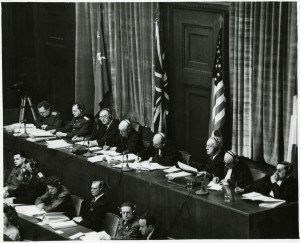 Three-and-a-half years later, the stated intention to punish the Germans was much more trenchant. On 1 November 1943, the Soviet Union, the United Kingdom and the United States published their “Declaration on German Atrocities in Occupied Europe,” which gave a “full warning” that, when the Nazis were defeated, the Allies would “pursue them to the uttermost ends of the earth … in order that justice may be done. … The above declaration is without prejudice to the case of the major war criminals whose offences have no particular geographical location and who will be punished by a joint decision of the Government of the Allies.” This Allied intention to dispense justice was reiterated at the Yalta Conference and at Berlin in 1945.
Three-and-a-half years later, the stated intention to punish the Germans was much more trenchant. On 1 November 1943, the Soviet Union, the United Kingdom and the United States published their “Declaration on German Atrocities in Occupied Europe,” which gave a “full warning” that, when the Nazis were defeated, the Allies would “pursue them to the uttermost ends of the earth … in order that justice may be done. … The above declaration is without prejudice to the case of the major war criminals whose offences have no particular geographical location and who will be punished by a joint decision of the Government of the Allies.” This Allied intention to dispense justice was reiterated at the Yalta Conference and at Berlin in 1945.
British War Cabinet documents, released on 2 January 2006, showed that as early as December 1944, the Cabinet had discussed their policy for the punishment of the leading Nazis if captured. British Prime Minister Winston Churchill had then advocated a policy of summary execution in some circumstances, with the use of an Act of Attainder to circumvent legal obstacles, being dissuaded from this only by talks with US and Soviet leaders later in the war.
In late 1943, during the Tripartite Dinner Meeting at the Tehran Conference, the Soviet leader, Joseph Stalin, proposed executing 50,000–100,000 German staff officers. US President Franklin D. Roosevelt, joked that perhaps 49,000 would do. Churchill, believing them to be serious, denounced the idea of “the cold blooded execution of soldiers who fought for their country” and that he’d rather be “taken out in the courtyard and shot” himself than partake in any such action. However, he also stated that war criminals must pay for their crimes and that in accordance with the Moscow Document which he himself had written, they should be tried at the places where the crimes were committed. Churchill was vigorously opposed to executions “for political purposes.” According to the minutes of a Roosevelt-Stalin meeting at Yalta, on 4 February 1945, at the Livadia Palace, President Roosevelt “said that he had been very much struck by the extent of German destruction in the Crimea and therefore he was more bloodthirsty in regard to the Germans than he had been a year ago, and he hoped that Marshal Stalin would again propose a toast to the execution of 50,000 officers of the German Army.”
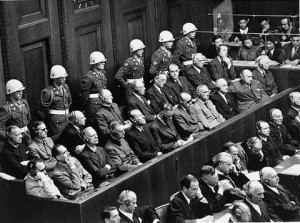 US Secretary of the Treasury, Henry Morgenthau, Jr., suggested a plan for the total denazification of Germany; this was known as the Morgenthau Plan. The plan advocated the forced de-industrialisation of Germany and the summary execution of so-called “arch-criminals”, i.e. the major war criminals. Roosevelt initially supported this plan, and managed to convince Churchill to support it in a less drastic form. Later, details were leaked to the public, generating widespread protest. Roosevelt, aware of strong public disapproval, abandoned the plan, but did not adopt an alternate position on the matter. The demise of the Morgenthau Plan created the need for an alternative method of dealing with the Nazi leadership. The plan for the “Trial of European War Criminals” was drafted by Secretary of War Henry L. Stimson and the War Department. Following Roosevelt’s death in April 1945, the new president, Harry S. Truman, gave strong approval for a judicial process. After a series of negotiations between Britain, the US, Soviet Union and France, details of the trial were worked out. The trials were to commence on 20 November 1945, in theBavarian city of Nuremberg.
US Secretary of the Treasury, Henry Morgenthau, Jr., suggested a plan for the total denazification of Germany; this was known as the Morgenthau Plan. The plan advocated the forced de-industrialisation of Germany and the summary execution of so-called “arch-criminals”, i.e. the major war criminals. Roosevelt initially supported this plan, and managed to convince Churchill to support it in a less drastic form. Later, details were leaked to the public, generating widespread protest. Roosevelt, aware of strong public disapproval, abandoned the plan, but did not adopt an alternate position on the matter. The demise of the Morgenthau Plan created the need for an alternative method of dealing with the Nazi leadership. The plan for the “Trial of European War Criminals” was drafted by Secretary of War Henry L. Stimson and the War Department. Following Roosevelt’s death in April 1945, the new president, Harry S. Truman, gave strong approval for a judicial process. After a series of negotiations between Britain, the US, Soviet Union and France, details of the trial were worked out. The trials were to commence on 20 November 1945, in theBavarian city of Nuremberg.
Creation of the courts
On 14 January 1942, representatives from the nine countries occupied by Germany met in London to draft the “Inter-Allied Resolution on German War Crimes”. At the meetings in Tehran (1943), Yalta (1945) and Potsdam (1945), the three major wartime powers, the United Kingdom, United States, and the Soviet Union, agreed on the format of punishment for those responsible for war crimes during World War II. France was also awarded a place on the tribunal. The legal basis for the trial was established by the London Charter, which was agreed upon by the four so-called Great Powers on 8 August 1945, and which restricted the trial to “punishment of the major war criminals of the European Axis countries”.
Some 200 German war crimes defendants were tried at Nuremberg, and 1,600 others were tried under the traditional channels of military justice. The legal basis for the jurisdiction of the court was that defined by the Instrument of Surrender of Germany. Political authority for Germany had been transferred to the Allied Control Council which, having sovereign power over Germany, could choose to punish violations of international law and the laws of war. Because the court was limited to violations of the laws of war, it did not have jurisdiction over crimes that took place before the outbreak of war on 1 September 1939.
Leipzig and Luxembourg were briefly considered as the location for the trial. The Soviet Union had wanted the trials to take place in Berlin, as the capital city of the ‘fascist conspirators,’ but Nuremberg was chosen as the site for two reasons, with the first one having been the decisive factor:
- The Palace of Justice was spacious and largely undamaged (one of the few buildings that had remained largely intact through extensive Allied bombing of Germany), and a large prison was also part of the complex.
- Nuremberg was considered the ceremonial birthplace of the Nazi Party. It had hosted the Party’s annual propaganda rallies and the Reichstag session that passed the Nuremberg Laws. Thus it was considered a fitting place to mark the Party’s symbolic demise.
As a compromise with the Soviets, it was agreed that while the location of the trial would be Nuremberg, Berlin would be the official home of the Tribunal authorities. It was also agreed that France would become the permanent seat of the IMT and that the first trial (several were planned) would take place in Nuremberg.
Most of the accused had previously been detained at Camp Ashcan, a processing station and interrogation center in Luxembourg, and were moved to Nuremberg for the trial.
Participants
Each of the four countries provided one judge and an alternate, as well as a prosecutor.
Judges
 Major General Iona Nikitchenko (Soviet main)
Major General Iona Nikitchenko (Soviet main) Lieutenant Colonel Alexander Volchkov (Soviet alternate)
Lieutenant Colonel Alexander Volchkov (Soviet alternate) Colonel Sir Geoffrey Lawrence (British main), President of the Tribunal
Colonel Sir Geoffrey Lawrence (British main), President of the Tribunal Sir Norman Birkett (British alternate)
Sir Norman Birkett (British alternate) Francis Biddle (American main)
Francis Biddle (American main) John J. Parker (American alternate)
John J. Parker (American alternate) Professor Henri Donnedieu de Vabres (French main)
Professor Henri Donnedieu de Vabres (French main) Robert Falco (French alternate)
Robert Falco (French alternate)
Chief Prosecutors
 Attorney General Sir Hartley Shawcross (United Kingdom)
Attorney General Sir Hartley Shawcross (United Kingdom) Supreme Court Justice Robert H. Jackson (United States)
Supreme Court Justice Robert H. Jackson (United States) Lieutenant-General Roman Andreyevich Rudenko (Soviet Union)
Lieutenant-General Roman Andreyevich Rudenko (Soviet Union) François de Menthon, later replaced by Auguste Champetier de Ribes (France)
François de Menthon, later replaced by Auguste Champetier de Ribes (France)
Assisting Jackson were the lawyer Telford Taylor, Stephen E. Burgio, Thomas J. Dodd and a young US Armyinterpreter named Richard Sonnenfeldt. Assisting Shawcross were Major Sir David Maxwell-Fyfe and Sir John Wheeler-Bennett. Mervyn Griffith-Jones, later to become famous as the chief prosecutor in the Lady Chatterley’s Lover obscenity trial, was also on Shawcross’s team. Shawcross also recruited a young barrister, Anthony Marreco, who was the son of a friend of his, to help the British team with the heavy workload.
Defense Counsel
The majority of defense attorneys were German lawyers. These included Georg Fröschmann, Heinz Fritz (Hans Fritzsche), Otto Pannenbecker (Wilhelm Frick), Alfred Thoma (Alfred Rosenberg), Kurt Kauffmann (Ernst Kaltenbrunner), Hans Laternser (general staff and high command), Franz Exner (Alfred Jodl), Alfred Seidl (Hans Frank), Otto Stahmer (Hermann Göring), Walter Ballas (Gustav Krupp von Bohlen und Halbach), Hans Flächsner (Albert Speer), Günther von Rohrscheidt (Rudolf Heß), Egon Kubuschok (Franz von Papen), Robert Servatius (Fritz Sauckel), Fritz Sauter (Joachim von Ribbentrop), Walther Funk (Baldur von Schirach), Hanns Marx (Julius Streicher), Otto Nelte and Herbert Kraus. The main counsels were supported by a total of 70 assistants, clerks and lawyers. The defense counsel witnesses included several men who took part in the war crimes during World War II, such as Rudolph Hoess. The men testifying for the defense hoped to receive more lenient sentences. All of the men testifying on behalf of the defense were found guilty on several counts.
Trial
The International Military Tribunal was opened on November 20, 1945, in the Palace of Justice in Nuremberg. The first session was presided over by the Soviet judge, Nikitchenko. The prosecution entered indictments against 24 major war criminals and seven organizations – the leadership of the Nazi party, the Reich Cabinet, the Schutzstaffel (SS), Sicherheitsdienst (SD), the Gestapo, the Sturmabteilung (SA) and the “General Staff and High Command”, comprising several categories of senior military officers. These organizations were to be declared “criminal” if found guilty.
The indictments were for:
- Participation in a common plan or conspiracy for the accomplishment of a crime against peace
- Planning, initiating and waging wars of aggression and other crimes against peace
- War crimes
- Crimes against humanity
The 24 accused were, with respect to each charge, either indicted but not convicted (I), indicted and found guilty (G), or not charged (-), as listed below by defendant, charge, and eventual outcome:
| Name | Penalty | Notes | ||||
|---|---|---|---|---|---|---|
| 1 | 2 | 3 | 4 | |||
|
Martin Bormann: Successor to Hess as Nazi Party Secretary. Sentenced to death in absentia. Remains found in Berlin in 1972 and dated to have died in 1945. |
I | — | G | G | Death | |
|
Karl Dönitz: Leader of the Kriegsmarine from 1943, succeeded Raeder. Initiator of the U-boatcampaign. Briefly became President of Germany following Hitler’s death. Convicted of carrying out unrestricted submarine warfare in breach of the 1936 Second London Naval Treaty, but was not punished for that charge because the United States committed the same breach. Defense attorney: Otto Kranzbühler |
I | G | G | — | 10 years | |
|
Hans Frank: Reich Law Leader 1933–45 and Governor-General of the General Government in occupied Poland 1939–45. Expressed repentance. |
I | — | G | G | Death | |
|
Wilhelm Frick: Hitler’s Minister of the Interior 1933–43 and Reich Protector of Bohemia-Moravia 1943–45. Co-authored the Nuremberg Race Laws. |
I | G | G | G | Death | |
|
Hans Fritzsche: Popular radio commentator; head of the news division of the Nazi Propaganda Ministry. Released early in 1950. Fritzsche had made himself a career within German radio, because his voice was similar to Goebbels.’ |
I | I | I | — | Acquitted | |
|
Walther Funk: Hitler’s Minister of Economics; succeeded Schacht as head of the Reichsbank. Released because of ill health on 16 May 1957. Died 31 May 1960. |
I | G | G | G | Life imprisonment | |
|
Hermann Göring: Reichsmarschall, Commander of the Luftwaffe 1935–45, Chief of the 4-Year Plan 1936–45, and original head of the Gestapo before turning it over to the SS in April 1934. Originally the second-highest-ranked member of the Nazi Party and Hitler’s designated successor, he fell out of favor with Hitler in April 1945. Highest ranking Nazi official to be tried at Nuremberg. Committed suicide the night before his execution.
|
G | G | G | G | Death | |
|
Rudolf Hess: Hitler’s Deputy Führer until he flew to Scotland in 1941 in an attempt to broker peace with Great Britain. Had been imprisoned since then. After trial, incarcerated at Spandau Prison where he allegedly committed suicide in 1987.
|
G | G | I | I | Life imprisonment | |
|
Alfred Jodl: Wehrmacht Generaloberst, Keitel’s subordinate and Chief of the OKW’s Operations Division 1938–45. Signed orders for the summary execution of Allied commandos and Soviet commissars Signed the instruments of unconditional surrender on 7 May 1945 in Reims as the representative of Karl Dönitz. Posthumously rehabilitated in 1953.
|
G | G | G | G | Death | |
|
Highest-ranking SS leader to be tried at Nuremberg. Chief of RSHA 1943–45, the Nazi organ comprised of the intelligence service (SD), Secret State Police (Gestapo), Criminal Police (Kripo) and had overall command over the Einsatzgruppen.
|
I | — | G | G | Death | |
|
Wilhelm Keitel: Head of Oberkommando der Wehrmacht (OKW) and def facto defence minister 1938–45. Known for his unquestioning loyalty to Hitler. Signed numerous orders calling for soldiers and political prisoners to be executed. Expressed repentance.
|
G | G | G | G | Death | |
|
Major industrialist. C.E.O. of Friedrich Krupp AG 1912–45. Medically unfit for trial; he had been partially paralyzed since 1941. Due to an error, Gustav, instead of his son Alfried (who ran Krupp for his father during most of the war), was selected for indictment. The prosecutors attempted to substitute his son in the indictment, but the judges rejected this due to proximity to trial. However, the charges against him remained on record in the event he should recover (he died in February 1950). Alfried was tried in a separate Nuremberg trial (the Krupp Trial) for slave labor, thereby escaping worse charges and possible execution.
|
I | I | I | — | ||
|
Head of DAF, German Labour Front. Committed suicide on 25 October 1945, before the trial began. Indicted but neither acquitted nor found guilty as trial did not proceed.
|
I | I | I | I | — | |
|
Baron Konstantin von Neurath:
|
G | G | G | G | 15 years | |
|
Chancellor of Germany in 1932 and Vice-Chancellor under Hitler in 1933–34. Ambassador to Austria 1934–38 and ambassador to Turkey 1939–44. Although acquitted at Nuremberg, von Papen was reclassified as a war criminal in 1947 by a German de-Nazification court, and sentenced to eight years’ hard labour. He was acquitted following appeal after serving two years.
|
I | I | — | — | Acquitted | |
|
Commander In Chief of the Kriegsmarine from 1928 until his retirement in 1943, succeeded by Dönitz. Released (ill health) 26 September 1955. Died 6 November 1960.
|
G | G | G | — | Life imprisonment | |
|
Ambassador-Plenipotentiary 1935–36. Ambassador to the United Kingdom 1936–38. Minister of Foreign Affairs 1938–45.
|
G | G | G | G | Death | |
|
Racial theory ideologist. Later, Minister of the Eastern Occupied Territories 1941–45.
|
G | G | G | G | Death | |
|
Gauleiter of Thuringia 1927–45. Plenipotentiary of the Nazi slave labor program 1942–45. Defense attorney: Robert Servatius
|
I | I | G | G | Death | |
|
Prominent banker and economist. Pre-war president of the Reichsbank 1923–30 & 1933–38 and Economics Minister 1934–37. Admitted to violating the Treaty of Versailles. Many at Nuremberg alleged that the British had brought about Schacht’s acquittal to safeguard German industrialists and financiers; Francis Biddle revealed Geoffrey Lawrence had argued that Schacht, being a “man of character”, was nothing like the other “ruffians” on trial. By 1944, he had been imprisoned in a KZ by the Nazis, and was not pleased to be put to trial as a major war criminal.
|
I | I | — | — | Acquitted | |
|
Head of the Hitlerjugend from 1933–40, Gauleiter of Vienna 1940–45. Expressed repentance.
|
I | — | — | G | 20 years | |
|
Instrumental in the Anschluss and briefly Austrian Chancellor 1938. Deputy to Frank in Poland 1939–40. Later, Reich Commissioner of the occupied Netherlands 1940–45. Expressed repentance.
|
I | G | G | G | Death | |
|
Hitler’s friend, favorite architect, and Minister of Armaments from 1942 until the end of the war. In this capacity, he was ultimately responsible for the use of slave laborers from the occupied territories in armaments production. Expressed repentance.
|
I | I | G | G | 20 Years | |
|
Gauleiter of Franconia 1922–40, when he was relieved of authority but allowed by Hitler to keep his official title. Publisher of the anti-semitic weekly newspaper, Der Stürmer.
|
I | — | — | G | Death | |

